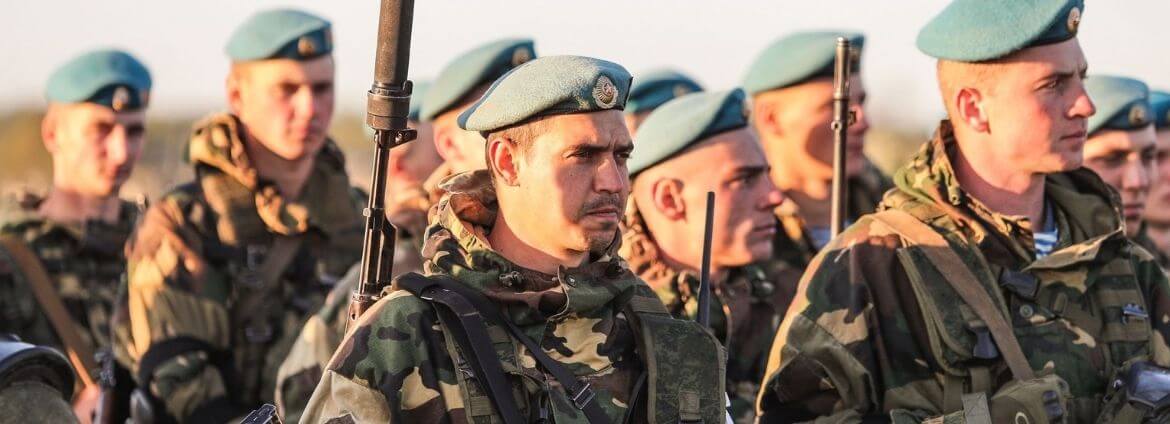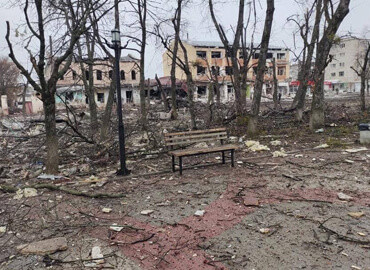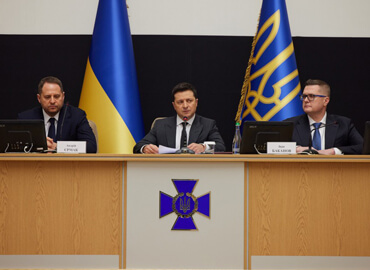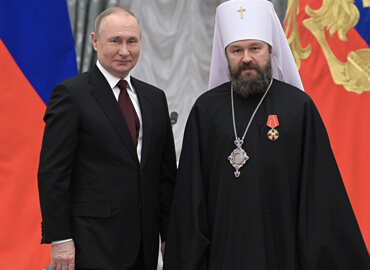Russian paratroopers are landing in Belarus near the border with Poland. The U.S. is warning Europe about possible preparations for an invasion of Ukraine by Russia. The Kremlin, with the help of Lukashenko, is attacking Europe with illegal migrants. How far will Lukashenko go in exchange for the Kremlin’s support, and will Russia get their military bases in Belarus?
Minsk and Moscow, together with integration programs, approved the military doctrine of the Union State. This was another step towards strengthening the military presence of Russia in Belarus and expanding Russian-Belarusian military cooperation – cooperation on the Kremlin’s terms and of benefit to the Kremlin.
Kyiv was not forgotten here either. Together with NATO and the countries of the «collective West,» Ukraine is portrayed by Kremlin and Belarusian state propaganda as a hostile territory from which an attack can be expected at any moment.
Misinformation about Ukraine’s preparation for a possible war with Russia at the end of October took up 17% of Russian mainstream media, with coverage of Bayraktar’s strike on the Russian howitzer covering 16%. These two «Ukrainian» topics have become the most often repeated in Russian media for the period.
At the same time, statements are emanating from the Kremlin that the path of negotiations and political agreements with Ukraine is futile. Both Putin and Medvedev wrote about this in their respective articles, accusing Kyiv of aiming at «total confrontation with Russia on the brink of war.»
Against this background, the signing of a military doctrine between Russia and Belarus, the unplanned movements of Russian tank forces and airborne forces, and the combat readiness of Russian strategic bombers on the Belarusian borders look like part of a planned game, the goal of which is to raise the stakes as high as possible. And the trump card in this game is the threat of offensive operations, including the use of Belarusian territory.
The essence of the deal is that Belarus «provides Russia with strategic depth towards the west.» The Kremlin is blurring the lines between the use of force and the threat of its use, maintaining constant tension while conducting media operations.
Belarus is a strategic foothold in Europe
The desire to integrate Belarus into the Russian military infrastructure as closely and for as long as possible has long been traced in various documents promoted by the Kremlin in the military sphere. This includes obligations of joint military planning, coordination of actions, and joint use of infrastructure projects.
Official documents concerning military cooperation are purely declarative, but overall they give a good picture of in which direction and in whose interests this deepening should take place. This is also evidenced by Russia’s previous attempts to place a military airbase on Belarusian territory.
Under the 1999 Union Treaty, Belarus and Russia should pursue a coordinated foreign policy and a joint defense policy, coordinate activities in the field of military construction, develop their armed forces, and use military infrastructure jointly.
The 1999 agreement on military cooperation between Russia and Belarus foresees the creation of a regional force, the planning of its use, operational and material support, unification of its command and control system, as well as the maintenance and use of military infrastructure facilities of both states, taking into account the military-political situation.
Russia’s military doctrine, adopted in 2014, names the main priorities of military-political cooperation with Belarus the coordination of activities for the development of the national armed forces and the use of military infrastructure and the development and coordination of measures to maintain the defense capability of the Union State in accordance with the military doctrine of the Union State. This essentially lays out the Kremlin’s goals in Belarus – the control of the Belarusian armed forces and military presence in country.
Lukashenko is bargaining
However, the Kremlin’s attempts to strengthen and consolidate its military presence in Belarus could not be called particularly successful until 2020.
The process stalled in 2018 following a demand from then Russian Prime Minister Dmitry Medvedev to effectively renounce Belarus’s independence in exchange for support. Putin was then forced to unilaterally approve the military doctrine of the Union State of Russia and Belarus.
Until recently, no decision on full-fledged military bases was made, and Lukashenko limited himself to bold statements that «if necessary, Belarus will turn into a single base for Belarus and Russia. A military base.»
And only the desire to stay in power at all costs, repressions against democratic forces, the elimination of independent media and civil society, and the rapid criminalization of the Lukashenko regime led to him falling into total dependence on Putin’s support. The payment for this support was the signing of a joint military doctrine.
Consolidating the military presence
Until 2020, the Russian military infrastructure in Belarus essentially did not develop and stood at the level of a functioning Gantsevichi radio-technical unit in the Brest region and the Russian Navy communication site in Vileika in the Minsk region. These facilities operated through a 1995 agreement between Russia and Belarus.
On October 20 this year, the Ministers of Defense of Russia and Belarus, Sergei Shoigu and Viktor Khrenin, signed an agreement to extend the use of these facilities.
The Kremlin received a real opportunity to consolidate its military presence in Belarus. Events on the border with Poland and the strengthening of military cooperation indicate that the Kremlin intends soon to make use of this opportunity. For Ukraine, this also means the emergence of a real military threat coming from Belarus.
Secretary of the Union State Dmitry Mezentsev commented on the military doctrine as part of the signing of the Treaty on creating the Union State: «The new military doctrine will increase the level of cohesion of defense policy and timely adapt the tasks of the defense ministries, taking into account the changes in the military-political situation in the region.»
The way the defense policy of Russia has developed can be traced through the example of the occupation of Crimea and the support of terrorist groups of the so-called LPNR.
As the experience with Ukraine has shown, the Russian military presence always serves as a basis for expanding and intensifying the activities of Russian special services and military intelligence, for conducting operations, including media operations, so that Russia’s political, economic, media, and military influence can be consolidated.
In addition to the strengthening of the military presence of Russia in Belarus already mentioned, one should note the signing in March of a five-year strategic partnership by the heads of the defense departments of Russia and Belarus, Sergei Shoigu and Viktor Khrenin, an agreement on the creation of three training centers for joint training of military personnel, including a training center for the air force and air defense forces in Belarus’s Grodno region.
In the context of the expansion of the Russian military presence after 2020, one should consider the scale of the Zapad-2021 exercises, the joint deployment of Russian and Belarusian air defense forces and having the air force being on alert, as well as Lukashenko’s plans to purchase Russian weapons.
A strategy of escalation
The worsening of relations between Belarus and neighboring countries, primarily NATO countries, is used by Russia as an argument for building up its military presence.
With the transition to an active hybrid attack using migrants against Poland, joint military maneuvers have become much more demonstrative. Russian fighters are already on alert in the general air defense system.
In November, Russian TU-22M3 strategic bombers were used patrol the air borders with Poland, Lithuania, and Ukraine. According to the Belarusian Defense Ministry, such flights will now be regular. On November 11, two Russian strategic TU-160 bombers practiced a bombing simulation at Belarus’s Ruzhansky air range 60 kilometers from the Polish border.
On November 12, Russia sent airborne units to Belarus, supposedly to conduct exercises to «spot check the combat readiness of the Airborne Forces.» As part of these «exercises» at the Gozhsky training ground, which is located 5 km from the Lithuanian border and 30 km from the border with Poland, a joint tactical airborne assault of the special operations forces of the Belarusian armed forces and Russian airborne troops was carried out using IL-76 military transport and Belarusian helicopters.
In this way the Kremlin, using Lukashenko’s dependence on Russian support and tactics for escalating the situation, is seeking to maximize and consolidate its military presence in the region.
An attack using migrants
To justify inundating Belarus’s territory with a Russian military presence, the pretext of ensuring security in the region and protecting the Union State can also be used. The narratives on creating the image of an enemy from the «collective West» and Ukraine, promoted by pro-Kremlin media, will also come in handy.
One of the possible scenarios for a hybrid attack using migrants on Poland may be to justify the deployment of Russian troops on Belarusian soil. For this, for example, a provocation could be organized on the border that will force the Polish side to use force. Or such a confrontation could be staged.
The time frame for the full consolidation of the Russian military presence in Belarus remains a question. Several options are possible here. Either the Kremlin has already agreed on a permanent military presence in exchange for supporting Lukashenko, or it is putting pressure on the regime and forcing concessions. Most likely, the truth lies somewhere between, and Lukashenko is trying to maneuver and bargain for more preferences to hold out as long as possible.
A threat for Ukraine
One thing is for sure – each scenario for the development of events in Belarus, influenced by the Kremlin, threatens Ukraine. The military threat coming from Belarus is being created against the backdrop of the crisis and Russian blackmail in the energy sector, including the introduction of Nord Stream-2.
At the same time, the crisis provides Ukraine with new opportunities to strengthen interaction with partners, in particular Poland and the Baltic countries, and to seek new points and areas for interaction.
Now the fact that the Ukrainian-Belarusian border is turning into a border of Ukraine with Russia needs to be reckoned with.
Материал доступен на русском языке: Российские бомбардировщики на границе с Украиной











